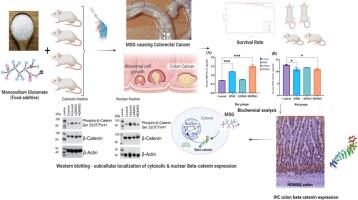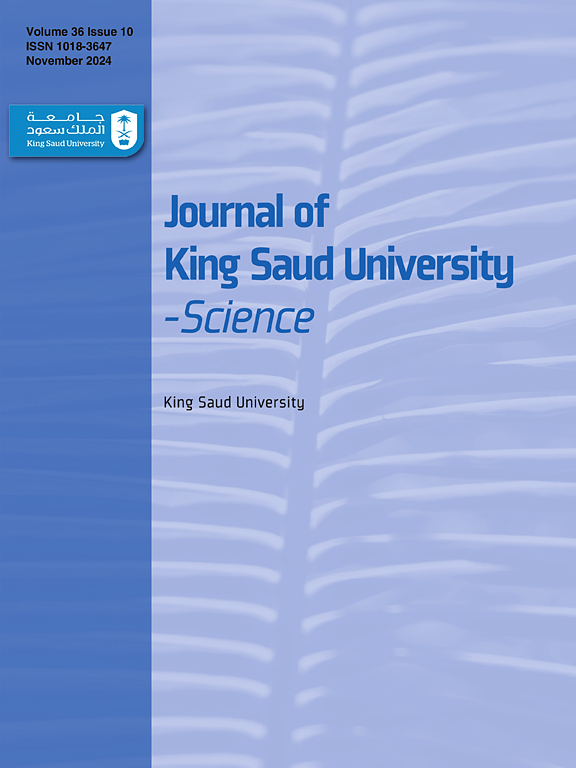Investigating the colon toxicity and carcinogenic role of monosodium glutamate compared with Dimethylhydrazine in male Wistar rats: Exploring the link to childhood colon cancer risk
IF 3.6
3区 综合性期刊
Q1 MULTIDISCIPLINARY SCIENCES
引用次数: 0
Abstract
Background
Colon cancer is rising among younger population than elder people. About 50% of colon cancer cases attributed to dietary factors. Monosodium glutamate (MSG) widely used taste enhancer prevalent in fast foods and processed items.
Objectives
The study investigated into the potential toxic and carcinogenic role of MSG in male Wistar rats of 1–3 months old and compared the effects with the Dimethyl hydrazine (DMH): by observing survival probability, estimation of serum biochemical parameters, and analysis for colon beta catenin protein expression.
Methods
Rats were grouped into control, DMH (s.c), low- and high dose MSG (LDMSG, HDMSG) (p.o). Survival rate statistically calculated using Kaplan-Meier plots and Log-rank tests. Biochemical analyses were done using standard protocols and one-way ANOVA were performed for data analysis. Beta catenin protein expressions were studied using immunohistochemistry and western blotting.
Results
Our study emphasizes that high dose MSG consumed male Wistar rats cause high decline in survival rate compared to low dose MSG and DMH. Estimated serum biochemical parameters showed significantly increased oxidative stress, altered liver and kidney function markers, alongside elevated serum sodium, total cholesterol, triglycerides, LDL, and inflammatory markers. Observed, colon polyps formed in DMH and MSG rats. Rat’s colon immunohistochemistry study expressed β- catenin whereas Western blotting results confirmed the altered β- catenin and β-catenin phosphorylation ratios in cytosol and nuclear region were elevated in DMH-induced colon cancer (p value of 0.0002), MSG low dose (p value of 0.003) and high dose (p value of 0.01) statistically significant. These findings highlights declined survival probabilities and pronounced oxidative stress markers, organ function changes, disrupted lipid profiles, and increased nuclear β-catenin expression reveals the potential toxic and carcinogenic role of MSG is influencing colon cancer development in male Wistar rat models.
Conclusion
Based on the results, the study underscores the potential toxic and carcinogenic role of MSG, particularly at neoplastic stages of colon cancer in male Wistar rat models.

研究谷氨酸钠与二甲基肼对雄性 Wistar 大鼠结肠的毒性和致癌作用的比较:探索与儿童结肠癌风险的联系
背景结肠癌在年轻人群中的发病率高于老年人。约 50%的结肠癌病例归因于饮食因素。谷氨酸一钠(味精)被广泛用于快餐和加工食品中的增味剂。方法将大鼠分为对照组、DMH 组(s.c)、低剂量和高剂量味精组(LDMSG、HDMSG)(p.o)。采用 Kaplan-Meier 图和对数秩检验统计计算存活率。生化分析采用标准方案,数据分析采用单因素方差分析。结果我们的研究强调,与低剂量味精和 DMH 相比,雄性 Wistar 大鼠摄入高剂量味精会导致存活率大幅下降。估计的血清生化指标显示,氧化应激明显增加,肝肾功能指标发生变化,血清钠、总胆固醇、甘油三酯、低密度脂蛋白和炎症指标升高。观察发现,DMH 和味精大鼠结肠息肉形成。大鼠结肠免疫组化研究显示,DMH 诱导的结肠癌中,β- catenin 表达,而 Western 印迹结果证实,β- catenin 和 β-catenin 在细胞膜和核区的磷酸化比率发生了改变(p 值为 0.0002),MSG 低剂量(p 值为 0.003)和高剂量(p 值为 0.01)具有统计学意义。这些发现凸显了味精对雄性 Wistar 大鼠模型结肠癌发展的潜在毒性和致癌作用。
本文章由计算机程序翻译,如有差异,请以英文原文为准。
求助全文
约1分钟内获得全文
求助全文
来源期刊

Journal of King Saud University - Science
Multidisciplinary-Multidisciplinary
CiteScore
7.20
自引率
2.60%
发文量
642
审稿时长
49 days
期刊介绍:
Journal of King Saud University – Science is an official refereed publication of King Saud University and the publishing services is provided by Elsevier. It publishes peer-reviewed research articles in the fields of physics, astronomy, mathematics, statistics, chemistry, biochemistry, earth sciences, life and environmental sciences on the basis of scientific originality and interdisciplinary interest. It is devoted primarily to research papers but short communications, reviews and book reviews are also included. The editorial board and associated editors, composed of prominent scientists from around the world, are representative of the disciplines covered by the journal.
 求助内容:
求助内容: 应助结果提醒方式:
应助结果提醒方式:


